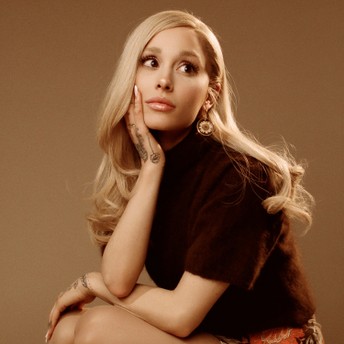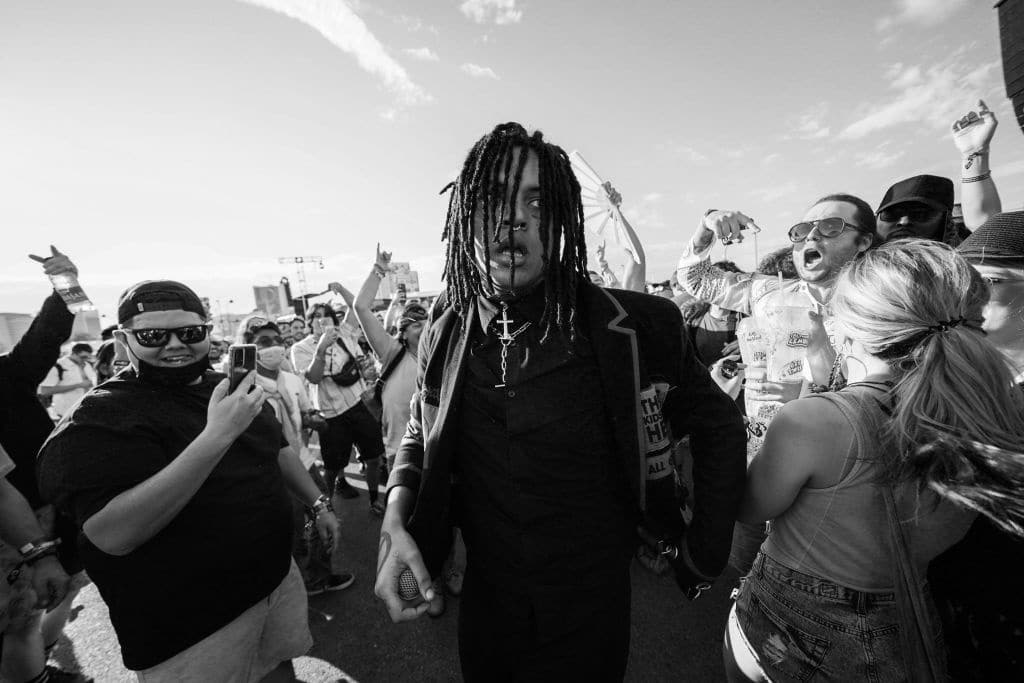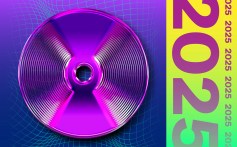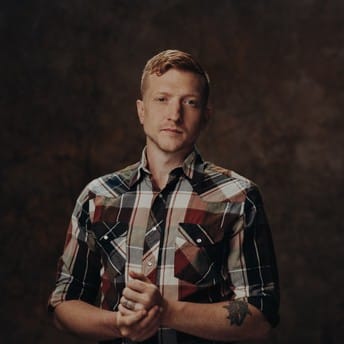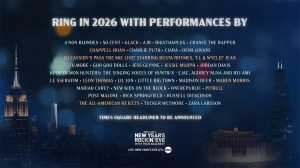Blog
Page: 3
Trending on Billboard
Warner Music Group (WMG) has hit apparel company PacSun with a copyright infringement lawsuit for allegedly using unlicensed music in advertisements and influencer videos on TikTok and Instagram.
The lawsuit, filed on Monday (Dec. 1) in California federal court, claims PacSun’s social media pages have illegally used hundreds of unlicensed tracks by top artists like Cardi B, Ariana Grande, Beyoncé, Dua Lipa, Charli xcx and Bruno Mars. WMG owns rights to these songs via various label subsidiaries, including Atlantic Records and Warner Records, and its publishing arm, Warner Chappell Music.
Related
According to the legal complaint, PacSun has invested heavily in social media marketing in recent years. WMG says the retailer has been “wildly successful” in selling apparel directly through posts on TikTok and Instagram, building up millions of followers and earning hundreds of millions of dollars in annual revenues.
“However, defendants achieved that success through their blatant, willful and repeated copyright infringement, including the infringement of at least 290 of plaintiffs’ most popular and valuable sound recordings and musical compositions,” write WMG’s lawyers at Sidley Austin.
While individual social media users can soundtrack their videos for free with songs covered by blanket licenses, companies are required to buy so-called sync licenses for music in commercial advertisements. There has been a spate of lawsuits in recent years from the major record labels against brands that use unlicensed music on Instagram and TikTok, including Bang Energy, Chili’s and Behr Paint.
Related
Like those previous lawsuits, WMG alleges here that PacSun uses copyrighted music to soundtrack its social media ads without buying sync licenses. The lawsuit also accuses PacSun of paying influencers to do the same, citing TikTok videos of influencers lip-syncing to Jack Harlow’s “WHATS POPPIN” and the Fleetwood Mac classic “Dreams” while encouraging followers to buy PacSun products.
WMG says it sent a cease-and-desist letter to PacSun back in February 2024, but to no avail: “Not only did PacSun explicitly choose to ignore the demand, its infringement both continued unabated as to several of the works identified by plaintiffs and expanded to include new, additional infringements,” reads the lawsuit.
Now, WMG is seeking a court injunction to stop the alleged infringement, as well as financial damages. The music company says it’s entitled to the maximum statutory damages of $150,000 per infringed work, which would add up to a whopping $43.5 million for all 290 of the songs at issue.
PacSun did not immediately return a request for comment on Tuesday (Dec. 2).
Trending on Billboard
Wicked: For Good bowed in November to blockbuster box office numbers, and has already racked up nearly $270 million in the U.S. alone, according to Box Office Mojo — numbers that may even result in the sequel becoming a bigger hit that the 2024’s successful original Wicked.
Explore
See latest videos, charts and news
Will its soundtrack also threaten to surpass the original? So far, it’s closer to on par with the original, matching its No. 2 debut on the Billboard 200 — with 122,000 in first-week units, down a tick from the 139,000 bow for Wicked the first — while notching four songs on the Hot 100, led by “For Good” (No. 43), the climactic duet between Cynthia Erivo’s Elphaba and Ariana Grande’s Glinda.
Are the numbers better or worse than we expected? And has the sequel or its soundtrack changed our opinion at all about the balance of Wicked‘s musical numbers? Billboard staffers discuss these questions and more below.
1. The Wicked: For Good soundtrack debuts at No. 2 on the Billboard 200 this week, with 122,000 first-week equivalent album units. Are those numbers higher, lower or about what you expected for it? Hannah Dailey: They might be a tiny bit higher than I expected, but overall, it’s more or less what I thought it would be. The Part 1 soundtrack was always going to perform better than Part 2, and a discrepancy of 17,000 between their respective first-week sales numbers isn’t a bad drop.
Stephen Daw: That’s right about where I anticipated this would land. The first Wicked soundtrack — which contains a lot of the show’s most popular songs — earned 139,000 equivalent album units, so to have it’s sequel put up pretty similar numbers feels about right.
Kyle Denis: This is about what I expected. A little lower than the first soundtrack, but still over 100k first-week units.
Joe Lynch: About what i expected – higher, if anything. The first Wicked soundtrack did 139k in its first week, and it was never gonna outdo that — “Defying Gravity” is a Broadway all timer, probably the most beloved show tune introduced in the 21st century. Without a tune THAT big, 122k is very respectable for first week.
Andrew Unterberger: Yeah, this feels about right — just a shame it was timed against a new set by Stray Kids, a group that’s literally never missed the No. 1 spot on the Billboard 200.
2. Much of the hype around the new film and particularly its soundtrack involves the debut of two new Stephen Schwartz-penned songs for the movie, the respective Cynthia Erivo and Ariana Grande showcases “No Place Like Home” and “The Girl in the Bubble.” Do they seem like worthy additions to the Wicked canon to you? Do you anticipate either becoming a new fan favorite? Hannah Dailey: Are they worthy additions? Sure. But I doubt they’ll become new favorites, especially among longtime fans of the Broadway musical. I do feel as though I understand Elphaba and Glinda better thanks to the added tracks, but neither song comes anywhere close — lyrically or musically – to the thrill and magic we associate with most of the rest of the musical’s numbers.
Stephen Daw: “No Place Like Home” and “The Girl in the Bubble,” while perfectly nice songs that do their jobs in the movie, cannot live up to the original Wicked songs. In terms of the plot of the second act, I think both tracks are at least effective at explaining both Elphaba and Glinda’s personal motivations in For Good — the problem is that both songs are pretty boring and so on-the-nose with their lyrics that it immediately takes you out of what’s happening both in the movie and in the music. I would be pretty surprised if fans of the musical adopted either of these songs as a new favorite, even with “Bubble” making its Hot 100 debut this week.
Kyle Denis: Both “No Place Like Home” and “The Girl in the Bubble” are incredibly boring. They feel like 2010s-era Disney soundtrack songs, and I think “Bubble,” in particular, suffers from haphazard editing in the film. I appreciate that both songs deepen and expand the motivations behind Galinda and Elphaba’s actions, but they both landed like duds in the theater. Cynthia and Ariana both sound great though, no surprise there!
Joe Lynch: “No Place Like Home” functions really beautifully in the film, emphasizing what’s at stake and drawing a clear connection to our country’s slide into fascism. It’s also crazy to me there wasn’t a song called “No Place Like Home” in the original production. (Perhaps Schwartz felt it was too on the nose, but it lands perfectly thanks to Erivo’s touch.) “Bubble” gives Grande a chance to flaunt some serious range, but runs a bit too long without offering enough melody. It doesn’t seemed tacked on, but it’s no future show tune karaoke classic either.
Andrew Unterberger: Nah. 3. The highest-debuting of the For Good songs on the Hot 100 is the title-track duet between Erivo and Grande, at No. 43. Does it feel like a defining / long-lasting rendering of the song? Do you anticipate a long chart run for it? Hannah Dailey: I absolutely think Erivo and Grande earned themselves a place in the Wicked history books with their stellar performance of “For Good.” As for its future career on the charts, I predict it’ll have a similar trajectory to their version of “Defying Gravity,” which spent a respectable 10 weeks on the Hot 100 after debuting at a similar peak position of No. 44.
Stephen Daw: It’s definitely one of the two best songs in the film (shoutout to Cynthia wailing her face off on “No Good Deed” as the capital-B Best Song in the movie), and both Ariana and Cynthia did a great job giving the song a slightly more earnest, sensitive touch with their vocal performances. That being said, while I think theater fans will point to this as a particularly good rendition of the song, I doubt it will have a massive chart reign. “Defying Gravity” is still the song from Wicked, and fans were truly obsessed (or “obsessulated,” as Glinda says) with Cynthia’s performance of that song — yet “Defying Gravity” peaked at No. 44 and remained on the Hot 100 for just 10 weeks. I doubt that “For Good” will fare much better or longer than that.
Kyle Denis: I think their recorded version of “For Good” is only beat out by their live performance of it at Wicked: One Wonderful Night alongside Oz OGs Idina Menzel and Kristin Chenoweth. A long chart run is more than likely out of the question — especially if some sort of radio edit isn’t released soon — but I expect Erivo & Grande’s “For Good” will be a defining rendition of the song within the Wicked fandom.
Joe Lynch: Given that fans had the OBC version of “Defying Gravity” memorized to the millisecond, I was pleasantly surprised to see Grande and Erivo’s marvelous version find a permanent home in fans’ hearts. Now, I feel I’m more likely to see drag queens lip syncing to the movie version than the cast recording. I think the same will prove true for “For Good” — it’s a standout cinematic moment and a recording that fans will return to for decades. A long chart run, however? That would leave me, to speak Ozian for a moment, surprisified.
Andrew Unterberger: I could see the song hanging on the chart through the holidays as the movie continues to gather steam, but life beyond that seems unlikely unless it catches particular fire on TikTok. It does feel like the recording will end up a fairly significant part of the legacy of not just the musical, but the two performers as well, though.
4. Some wariness about the Wicked movie being split in two was over the movie being traditionally thought to have a stronger first half musically. Does either the movie’s second part or its standalone soundtrack do much to combat that conventional wisdom, or does they mostly reinforce the musical’s top-heaviness? Hannah Dailey: The best chance Chu and Schwartz had at changing Act II for the better was with the addition of the two new songs, but unfortunately, neither “No Place Like Home” nor “For Good” had the oomph needed to do so, in my opinion. At points in the Broadway musical’s second half where they could have injected some much-needed momentum on screen, the writers instead slowed things down even more with softer numbers that hardly stand out against the rest of the music in Act II, much less compete with the quality of Act I.
Stephen Daw: It’s complicated — I think Wicked: For Good, all things being considered, did a very good job adapting the musical’s second act for film. There’s needed expansion for multiple characters, beats included to help audiences understand our main characters’ motivation and the inclusion of iconic moments from the stage show that we would have been disappointed to miss in the movie (I’m looking at you, catfight!).
But even with those additions and changes, Wicked: For Good still doesn’t really solve the “problems” in the second act, which has a lot to do with the music and the pacing. It’s still true that Act I is a better piece of musical theater Act II, in the same way that Wicked is a better movie than Wicked: For Good. While this version of the film is probably the best case scenario for a standalone movie of the back half of the musical, I still think that they could have made Wicked into one (admittedly long) movie musical, and it would have been better-balanced.
Kyle Denis: The film did a much better job translating the stage show’s messy second act, but, truthfully, I just cannot bring myself to care about Nessarose and Boq’s whole thing. The music remains weaker in the second half — and the new songs don’t help the matter. Even though Cynthia absolutely bodied her “No Good Deed” rendition and Ariana delivered one of her greatest vocal performances with “Thank Goodness” (Jon M. Chu will pay for how he butchered that song in the film!), those moments can’t carry the whole second act. Wicked’s always been top-heavy, and that wasn’t going to change on the silver screen.
Joe Lynch: I was against the movie being a two-parter for this very reason, but I’m happily eating crow now — both are satisfying and sumptuous films with emotional resonance. Musically, though, I think the first half still soars while the second part glides — not a fatal problem by any means (the show is still running on Broadway, after all) but there’s no denying that part one simply has more bangers. It’s a credit to what Chu has done, visually and dramatically, that Part 2 still feels like a standalone victory.
Andrew Unterberger: As someone with little Wicked knowledge going into the movies, I can’t say I noticed a huge drop-off in quality between the songs in Part 1 and Part 2. Honestly, if there was a drop-off, it was with those new songs written specifically for the movie. Otherwise, close enough. 5. Both Erivo and Grande were nominated for Oscars for the film’s first part, but went home empty-handed. Do you expect either will be nominated again for For Good — and could either emerge victorious this time? Hannah Dailey: If neither of these women get Oscar love this year, I’ll be shocked. Both delivered generational performances in this project, and with For Good’s emotionally meatier scriptproviding way more opportunities for them to shine as dramatic actresses, I think they have even better shots of taking home acting prizes next year than they did with Part 1.
Stephen Daw: For all the critical gripes about Wicked: For Good (plenty of which I personally agree with), the one thing I have consistently seen is critics praising both performances from Ariana and Cynthia. I’ll be surprised if they’re not both nominated a second time. In terms of the likelihood of either of them winning, it is a stacked awards season, but I think Ariana has the best chance out of the two of them to take home the trophy for the stellar acting performance she delivered in this movie.
Kyle Denis: As it stands, I think both will land repeats nods — which would be historic considering only six actors have received Oscar nominations for playing the same character in two different films. Grande is probably the frontrunner in best supporting actress, and she has a solid chance to take home the gold – especially if votes get split between the supporting players in Sinners, Sentimental Value and One Battle After Another. She may also face stiff competition from Weapons’ Amy Madigan, should critics rally around her early in the season. The actors’ branch clearly respects Erivo, so she should have no problem making the final five… whether she has enough steam to take down Hamnet’s Jessie Buckley is the real question.
Joe Lynch: Nominated? Likely. Erivo pulled off a tricky character transformation with pathos and aplomb, and she deserves a nod for that. Grande revealed a depth and breadth we didn’t see in part 1, so she might get recognized as well — but something tells me they’re unlikely to nominate both two years in a row and that Erivo has the edge. I would be surprised if it turns into a win for her — but that being said, she’ll get Oscar gold within the next decade, I’m sure.
Andrew Unterberger: If I had to guess, I’d say both get nominated again and both are left applauding in the audience again.

Trending on Billboard
Wicked: For Good director Jon M. Chu has had enough of the criticism of Ariana Grande and Cynthia Erivo‘s friendship throughout the press tour for both musical films.
At an American Cinematheque For Good screening and Q&A on Monday night (Dec. 1), Chu spoke out against the vitriol being thrown at his Wicked leading ladies for their openness in sharing their deep friendship with the world.
“For us to be at a time when you can have these two amazing women emerge from their shells to share love and friendship and the importance of that, unabashedly, no cynicism; to be able to share that vulnerability and wounds with the world, knowing people are going to come out with their knives, shame on people who put that down,” he says in a fan-filmed clip. “These girls are giving us everything; it is why people around the world are drawn to it. It’s why they love it, and they’re sharing a real friendship that happened on set that I got to be a part of, and we should honor that with everything that we have.”
Grande and Erivo, who both landed Oscar nominations for their acclaimed performances in 2024’s Wicked, frequently went viral on last year’s press tour due to their deeply emotional responses to questions and their physical comfort with one another. Notably, Billboard named the duo’s “holding space” moment, a viral interview clip in which Grande dramatically clutches Erivo’s elongated manicured nail, the No. 10 Greatest Pop Star Meme of All-Time. In addition to its dual Oscar wins, the first Wicked movie also became the highest-grossing musical film adaptation of all time, making over $750 million at the worldwide box office.
Wicked: For Good, which brings the Broadway musical’s second act to the silver screen, boasted a comparatively less aggressive press tour — but Grande and Erivo’s relationship quickly became the dominant talking point. After the press tour ended with a triple-whammy of Grande missing the Brazilian premiere, Erivo defending Grande from a red carpet rusher at the Singaporean premiere and Erivo losing her voice the night of the New York premiere (where Grande also contracted COVID-19), social media devolved into especially nasty attacks on both women’s bodies and appearances, as well as their overall intimacy. Over the holiday weekend (Nov. 29), Grande reposted a clip from a 2024 interview “as a loving reminder to all,” regarding the dangers of openly dissecting and criticizing people’s physical appearance.
Nonetheless, that online chatter didn’t stall Wicked: For Good at the box office. In its opening weekend, the film topped the worldwide box office, grossing $223 million and surpassing its predecessor to earn the highest opening weekend for a Broadway adaptation.
On the Billboard 200, the For Good soundtrack tied the No. 2 peak of its predecessor, with several songs landing on the Hot 100, including “For Good” (No. 43), “No Good Deed” (No. 56), “As Long As You’re Mine” (No. 91) and “The Girl in the Bubble” (No. 100). Furthermore, both Erivo and Grande remain formidable contenders in their respecitive categories at next March’s 98th Academy Awards.
Trending on Billboard
Mexican superstar Carín León has signed with WME’s global co-head of music, Kirk M. Sommer, in all areas, it was announced Tuesday (Dec. 2). Together with León’s manager, Jorge Juárez, the intention is to “grow León’s business and presence in territories beyond his current base.”
Related
“We are thrilled to join the WME team led by Kirk Sommer,” Juárez said in a statement. “Carín has tremendous potential to expand into other global territories. We are looking to WME to lead the way in all areas of their expertise.”
“Carín is a generational artist,” Sommer added. “In his incredible career, he has consistently broken barriers and transcended genres. We are determined to bring the full weight of WME to bear to expand Carín’s fanbase around the world and we are honored to work with both Carín and Jorge.”
Hailing from Hermosillo, Sonora, Mexico, León — known for his signature norteño sound fused with R&B, country and pop — is one of the most versatile voices in Latin music. His debut album, Desvelada con Banda y Mariachi (2018), propelled him to quickly dominate the regional Mexican music scene. In 2021, his album Inédito debuted atop multiple charts and was named one of Billboard’s 25 Best Latin Albums of the Year.
A Grammy and Latin Grammy Award winner, León became the first Latin artist ever to play Coachella and Stagecoach in the same year in 2024, and is now set to become the first Latin artist to play Sphere in Las Vegas, with a run of seven shows set for 2026. He has also sung at Nashville’s Grand Ole Opry, opened for legendary British band The Rolling Stones, and sold out the impressive GNP Seguros Stadium in Mexico City, among other achievements. Earlier this year, he set an attendance record at RODEOHOUSTON with over 70,000 fans showing up to see him perform.
Last month, León took home the Latin Grammy for best contemporary Mexican music album for Palabra De To’s (Seca), which is also up for a 2026 Grammy Award for best música mexicana album.
Source: FilmMagic / Getty
Sad news has broken that Florida rapper POORSTACY has reportedly passed away at 26.
According to the Palm Beach County Medical Examiner, Carlito Milford Jr., also known as POORSTACY, died on Saturday, November 29th. The Florida rapper had reportedly checked into a hotel with a woman and a child, where he had been staying for ten days. Medical personnel were called to his room, and he was transported to a hospital. His cause of death has not yet been confirmed.
STACY built a dedicated fanbase with his fusion of Hip-Hop and heavy metal, often collaborating with similar artists like Iann Dior. His most-streamed song, “Choose Life,” features Travis Barker, and they also collaborated on two albums under the 10K Projects label. POORSTACY was also a part of the “Bill & Ted the Music” soundtrack, which received a Grammy nomination.
Outside of music, Carlito Milfort Jr. faced legal trouble in 2023 after being arrested following a standoff with police. He was charged with battery and child neglect. The incident began after he was accused of assaulting a woman, reportedly throwing a cage containing a hamster at her and a one-month-old baby. POORSTACY was released shortly after on bond, and the case was ultimately dropped.
Fans of the Emo rapper have expressed their shock online as the news broke on the internet.
More updates are expected as details continue to come regarding the sudden passing of the Florida rapper.
As with just about every other industry in the world, some of music’s biggest issues in 2025 have revolved around the Trump administration. Artificial intelligence? Upon taking office, Trump revoked an order by President Biden that ensured “safe, secure and trustworthy development” of the technology. Share prices for public companies like Warner Music and Live […]
Trending on Billboard Miley Cyrus has something beautiful to share with fans. After four years of dating, the pop star is now engaged to musician Maxx Morando, as revealed Tuesday (Dec. 2) following the couple’s red-carpet appearance at the Avatar: Fire and Ash premiere. Stepping out with her fiancé at the film’s screening in Los […]
The sheer number of artist signings announced on a weekly basis makes it difficult to keep up, no matter how closely you pay attention to the industry news cycle. That’s why every other Tuesday, Billboard compiles the latest signings to labels, distributors, agencies, management companies and more, in an effort to provide a snapshot of the latest moves in the artist space, from household names to indie stars to emerging acts.
Related
To start this week, label and management company XOXO Entertainment signed Grammy-winning R&B group Blackstreet. Since 2014, the group’s lineup has featured original members Chauncey “Black” Hannibal and Levi Little, along with Mark Middleton and Eric Williams.
A press release indicates that announcements regarding new music and performances from the group are forthcoming.
“We are beyond excited to partner with Blackstreet,” said XOXO president Adam H. Hurstfield in a statement. “As some of the greatest architects of that legendary 90’s RnB sound, their music shaped the soundtrack of our lives, defined an era, and left an unmistakable imprint on global culture. Around the world, fans have been yearning for that authentic feeling again, and at XOXO Entertainment, we are devoted to bringing it back, side by side with the very legends who created it. We are honored to help amplify Blackstreet’s iconic legacy into this exciting new chapter.”
In its own statement, Blackstreet added that the group “has always stood for timeless music, true artistry, excellence, and evolution. Partnering with XOXO Entertainment feels like the perfect alignment; where vision, passion, and creativity meet. As a group, we’re excited and honored to join forces with a team that shares our energy and commitment to taking BLACKSTREET into a new era. This partnership is powerful, and together we’re ready to create moments the world will remember. This next chapter will be iconic.”
Blackstreet scored a Billboard Hot 100 No. 1 hit in 1996 with “No Diggity” featuring Dr. Dre, which spent four weeks at the chart’s summit. It also enjoyed success with tracks including “Before I Let You Go” and “Take Me There.”
Check out more of the latest artist signings below.
B2K (BPC Music Group)
Trending on Billboard Tyler Childers will hit the road next year, when his 2026 Snipe Hunt Tour launches April 23 in Dallas, Texas. The trek will visit 14 cities along the way, including stops in St. Louis, Chicago and Seattle, before wrapping Oct. 3 in Portland, Oregon. His Snipe Hunt tour is presented by LN […]
Trending on Billboard
Chappell Roan, Mariah Carey, Post Malone, Leon Thomas, Charlie Puth and HUNTR/X, who gave us the global smash “Golden” from KPop Demon Hunters, are among 33 artists set to perform on Dick Clark’s New Year’s Rockin’ Eve with Ryan Seacrest 2026 (NYRE). The roster is a mix of current hit artists and a few veteran acts, such as Rick Springfield, New Kids on the Block, 4 Non Blondes and Goo Goo Dolls.
This year’s show is set to run for eight hours – from Wednesday, Dec. 31 at 8:00 p.m. until the next morning at 4:00 a.m. ET on ABC, and the next day on Hulu. This is the 54th edition of the show, which launched in December 1972. It marks the longest telecast in the show’s history, including an additional 90 minutes of programming compared to last year, with more than 85 songs set to be performed.
This year’s broadcast will be led by Ryan Seacrest and co-host Rita Ora from New York’s Times Square. Chicago native Chance the Rapper will lead the show’s first-ever Central time zone countdown from Chicago. NFL legend Rob Gronkowski returns alongside performer Julianne Hough, who makes her NYRE co-hosting debut as they take over Las Vegas.
The Times Square headliner and special guests will be announced soon, as will details for the Puerto Rico celebration.
This marks the third consecutive year that Dick Clark Productions and iHeartMedia will broadcast Dick Clark’s New Year’s Rockin’ Eve with Ryan Seacrest live across 150 iHeartRadio stations nationwide, including Z100 New York, KIIS-FM Los Angeles, KISS FM Chicago, Q102 Philly and THE NEW MIX 102.9 Dallas. The show will also be available to stream live on the iHeartRadio app.
ABC’s Dick Clark’s New Year’s Rockin’ Eve with Ryan Seacrest has been the No. 1 New Year’s Eve special since 1977, when it surpassed Guy Lombardo’s long-running New Year’s Eve specials on CBS.
The Clark show, which was conceived as a younger, hipper alternative to the Lombardo program, debuted on NBC on New Year’s Eve 1972 as Three Dog Night’s New Year’s Rockin’ Eve. That year’s special featured pre-recorded musical performances by Helen Reddy, Billy Preston and Three Dog Night (all of whom had No. 1 or No. 2 singles on the Billboard Hot 100 that year). Clark served as a reporter from Times Square for live coverage of the ball drop and the arrival of 1973.
The second special, New Year’s Rockin’ Eve ’74, also on NBC, was hosted by comedian George Carlin and featured pre-recorded musical performances by Preston, The Pointer Sisters, Linda Ronstadt and Tower of Power.
Beginning with the December 1974 edition, the program moved to ABC and Clark assumed hosting duties; billed as Chicago’s New Year’s Rockin’ Eve 1975, the first ABC edition was headlined by Chicago, with guests The Beach Boys, The Doobie Brothers, Herbie Hancock and Olivia Newton-John.
Clark died in 2012 at age 82, but his name is still in the title of the show he created.
Last year, Carrie Underwood capped the night with a Times Square performance as the broadcast drew more than 29 million total viewers at midnight.
ABC’s Dick Clark’s New Year’s Rockin’ Eve with Ryan Seacrest 2026 is produced by Dick Clark Productions, with Ryan Seacrest, Michael Dempsey and Barry Adelman serving as executive producers.
Here’s a full list of performers who have been announced so far for Dick Clark’s New Year’s Rockin’ Eve with Ryan Seacrest 2026:
The All-American Rejects
AJR
BigXthaPlug
Chance the Rapper
Charlie Puth
Chappell Roan
Ciara
Demi Lovato
DJ Cassidy’s Pass the Mic Live! Starring Busta Rhymes, T.I. & Wyclef Jean
50 Cent
Filmore
4 Non Blondes
Goo Goo Dolls
Jess Glynne
Jessie Murph
Jordan Davis
KPop Demon Hunters: The Singing Voices of HUNTR/X – EJAE, Audrey Nuna and REI AMI
Leon Thomas
LE SSERAFIM
Lil Jon
Little Big Town
Madison Beer
Maren Morris, sponsored by Carnival Cruise Line
Mariah Carey
New Kids on the Block
OneRepublic
Pitbull
Post Malone
Rick Springfield
Russell Dickerson
6lack
Tucker Wetmore
Zara Larsson
Dick Clark’s New Year’s Rockin’ Eve
ABC
Dick Clark’s New Year’s Rockin’ Eve with Ryan Seacrest 2026 is produced by Dick Clark Productions, which is owned by Penske Media Eldridge, a joint venture between Eldridge Industries and Billboard parent company Penske Media.

 State Champ Radio
State Champ Radio 
